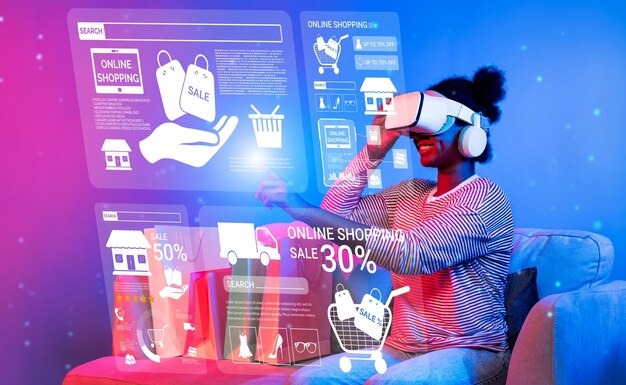How Augmented Reality is Transforming Online Shopping
Published on February 28, 2025

Author: Yiga Richard
Online shopping has revolutionized retail, making it easier than ever to browse and purchase products from anywhere. However, one challenge remains—customers can’t physically see or try products before buying. This is where Augmented Reality (AR) is changing the game. By bridging the gap between digital and physical shopping experiences, AR enhances product visualization, improves customer confidence, and reduces return rates.
In this blog, we’ll explore how AR is transforming e-commerce, its key benefits, and how businesses can leverage this technology to stay ahead.
The Rise of Augmented Reality in E-Commerce
Augmented Reality overlays digital elements onto the real world through a smartphone, tablet, or AR-enabled device. In online shopping, AR allows customers to virtually try products before purchasing—whether it’s seeing how furniture fits in their home, trying on clothes, or previewing makeup looks.
Major brands like IKEA, Sephora, and Nike have already integrated AR to enhance the shopping experience, making it more interactive and personalized.
Key Benefits of AR in Online Shopping
1. Enhanced Product Visualization
One of the biggest challenges of online shopping is uncertainty about how a product will look or fit in real life. AR eliminates this uncertainty by allowing customers to see 3D models of products in their actual environment.
For example, furniture retailers like IKEA use AR to let customers place virtual furniture in their rooms to check size, style, and fit before making a purchase.
2. Virtual Try-Ons for Apparel and Accessories
AR enables virtual fitting rooms where customers can see how clothes, accessories, and even makeup will look on them.
- Fashion brands like Gucci and Warby Parker offer AR-powered try-ons for shoes and glasses.
- Beauty brands like L’Oréal and Sephora allow customers to test different shades of makeup virtually.
This improves confidence in purchases and reduces return rates.
3. Reduced Product Returns
Returns are a major concern in e-commerce. Many customers return items because they don’t look or fit as expected. By providing a more accurate preview through AR, businesses can reduce mismatched expectations and cut down return rates significantly.
4. Increased Customer Engagement
AR makes online shopping more interactive and engaging. Instead of just scrolling through static images, customers can interact with products in a dynamic way. This leads to:
- Longer time spent on websites or apps
- Higher conversion rates
- Greater brand loyalty
5. Personalized Shopping Experience
AR enhances personalization by tailoring experiences to each user. Some platforms allow customers to input preferences or facial features to get customized product recommendations using AR simulations.
For example, Nike’s AR-powered shoe fitting tool scans customers’ feet to suggest the perfect shoe size.
6. Competitive Advantage for Businesses
Brands that integrate AR into their e-commerce strategy stand out from competitors by offering an innovative shopping experience. As AR adoption grows, businesses that embrace this technology will gain an edge in attracting and retaining customers.
How Businesses Can Implement AR in E-Commerce
To successfully integrate AR into online shopping, businesses should:
- Invest in AR Technology: Use AR software and apps that allow customers to interact with products.
- Ensure Mobile Compatibility: Optimize AR experiences for smartphones since most shoppers browse on mobile.
- Create High-Quality 3D Models: Provide clear, realistic 3D representations of products.
- Offer Seamless User Experience: Ensure AR features are easy to use and don’t require complex setup.
- Gather Customer Feedback: Continuously improve AR experiences based on user interactions and feedback.
Conclusion
Augmented Reality is redefining online shopping by making it more immersive, interactive, and personalized. From virtual try-ons to realistic product visualization, AR enhances customer confidence and improves the overall e-commerce experience.
As technology advances, AR will become a standard feature in online retail. Businesses that adopt AR early will gain a competitive edge and create a more engaging and satisfying shopping journey for their customers.
Are you ready to embrace AR in your e-commerce strategy? Now is the time to innovate and elevate your online shopping experience!